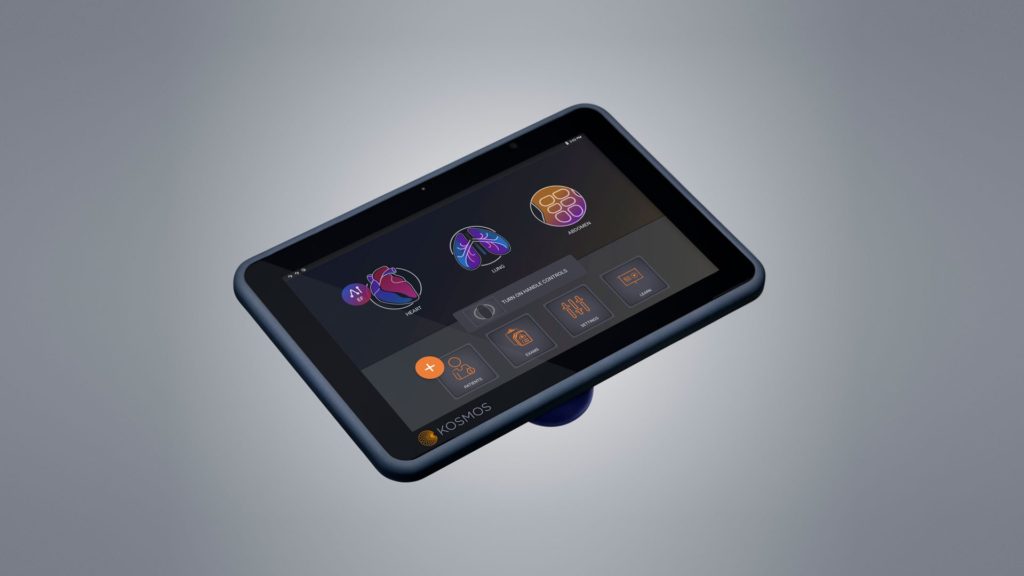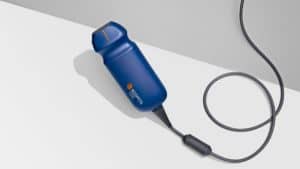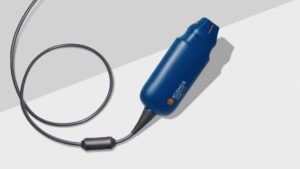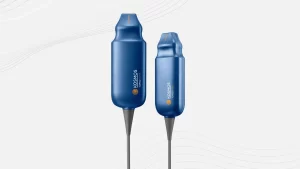A New Cardiology Tool That Lets You Reimagine Bedside Care
Why only listen when you can listen and see at the same time? Kosmos is giving cardiologists a game-changing view into the heart, one simple and easy bedside scan at a time.
Before Kosmos, cardiologists were limited in what they could use to diagnose patients bedside. They relied on a stethoscope. They listened to the heart. Or they took a “quick look” with a low-cost tool, then ordered an ultrasound taking up time, extending visits, and cost. If they did manage to get a point-of-care ultrasound (POCUS) to the bedside, scanning could be cumbersome or produce low-resolution images with limited quantitative capability.
Now, thanks to Kosmos’s advances in POCUS, they can see it—without leaving the patient’s side. Kosmos combines, in a single-phased array probe, three vital signals: digital stethoscope, EKG, and ultrasound. This enables doctors to understand what is occurring within the cardiac cycle, using transformative AI to improve technique and guide the physician.
The combination of those three signals—three of the most important in medicine—gives Kosmos an edge that no other POCUS device offers.
When I started doing point of care ultrasound two years ago, I suddenly realized that I was missing stuff.Dr. Nelson B. Schiller, MD, FACC
Founder of UCSF Echocardiography Lab and the UCSF Adult Congenital Heart Disease Clinic
“It’s pulling the bedsheets back, really,” says Dr. Nelson Schiller, a prominent cardiologist at the University of California San Francisco, who specializes in using ultrasound images of the heart’s movement to diagnose and treat heart disease. To him, Kosmos has made “a world of difference” treating patients.
Kosmos is enabling cardiologists to extract more information, helping them isolate problems faster and more efficiently than ever. It maximizes what doctors can do during routine visits, magnifying the vision they’d normally have using a stethoscope without having to wait on the results of an echo.
“Traditionally, we’d run through a whole bunch of different things this could be caused by,” says Dr. David Tierney, director of the internal medicine residency program at Northwestern Hospital, in Minneapolis, Minnesota. With Kosmos, however, Dr. Tierney can spend one minute and 40 seconds doing a scan, get a clear picture of what’s happening internally, and eliminate all but a few possibilities.

Kosmos magnifies effectiveness.
Dr. Schiller turned to Kosmos.
“I took a look and I realized one of her valves was bleeding like crazy,” Dr. Schiller says. “We can make her much better. But she just didn’t want to tell us [she was feeling ill]. This way, it’s pulling the bedsheets back, really.”
Finding openings in physician’s schedules can be difficult. In 2017, new patients waited 21.1 days on average before they were able to see their cardiologist—and patients in some cities, like Boston (45 days) and Portland (32) had to wait even longer. Moreover, the wait for an echo can chew up even more valuable time, as the insurance pre-approval process isn’t often expedient. Kosmos gives doctors the ability to make life-saving discoveries like that at bedside, without extra hassle for their patients.
“Doctor time is hard to come by, and the physicians themselves are hard to come by. They’re busy, and they need to be effective,” Dr. Schiller says. “This is a magnifier of effectiveness. A doctor’s visit is more effective if you can take a look at a patient’s heart. You don’t have to see that much, even. Just a few relevant things to make sure everything is as it’s supposed to be. That goes a long way.”
Even beyond saving time, Dr. Schiller is adamant that using Kosmos makes him a better physician. Like any tool, Kosmos is something that he’s had to learn. But thanks to the Kosmos AI, the barrier for entry to use the device is low, and the rate at which he’s become comfortable using it has been quick.
“It allows you to cut through the butter very quickly,” Dr. Schiller says. “If a patient comes with a problem, many of them can be solved immediately. You couldn’t do that before. And it builds on itself; if you get good at it, the more you learn. The more you learn, the more efficient you get.”
Kosmos’s AI allows doctors with little to no ultrasound experience to find quick, accurate diagnoses and administer care to those in need. That’s something especially important as physicians and hospitals attempt to adapt to the challenges of COVID-19. Kosmos can be a vital tool for cardiologists in the fight against the coronavirus.
“Patients with COVID who have a surprise heart problem, myocarditis, where the heart muscle gets involved,” says Dr. Tierney, “It can cause people to die quickly without having any idea why this person with COVID just died. Being able to say ‘let me just quickly take a peek at your heart here while I’m admitting you and make sure it looks good’ … Without question, it saves lives.”



How Kosmos makes the most out of a visit
Kosmos allows doctors to get the most out of visits with patients, amplifying their time with them. More than that, though, it helps physicians catch things they’d otherwise miss.
As a doctor spends more and more time with patients, Dr. Schiller says, they develop a bond. They become something like family. And like family, they tend to hide things out of fear of making visits unpleasant.
“They don’t want to bother you, they don’t want to tell you things, they want to please you more than they want to please themselves,” Dr. Schiller says. “And they come in, they don’t want to bother the doctor, they don’t want to disappoint the doctor. Because, say they’re sick, that means I didn’t treat them well. Kosmos is a great equalizer. It sees things.”
Point-of-care ultrasound can be a vital tool for doctors in diagnostics, thanks to its ability to deliver quick and accurate answers to tough questions. But reading ultrasounds and images can be difficult. Thankfully, Kosmos’s unparalleled AI makes it easy for physicians to know what they’re seeing, and for patients to receive top notch care.
“If you don’t know what you’re doing exactly, and you don’t get good images, and the patient is sitting there, you sucked up time from the visit and got nowhere,” Dr. Schiller says. “Which is why a lot of the automated approaches that Kosmos is taking are a great idea.”
“On busy days, it speeds up the day tremendously, because it takes five minutes or so of your time,” says Dr. Adaira Landry, assistant professor at Harvard Medical School and emergency medicine physician at Brigham and Women’s Hospital. “But if something looks normal, that patient can go home now, so I think it’s most helpful on a really busy day and in really critical patients.”
Kosmos’s AI capabilities give physicians an upper hand when diagnosing and treating patients that other POCUS devices don’t offer. They can see more patients, because they’re more efficient—or they can spend the time they save by having better, more detailed interactions with patients. As Dr. Schiller says, Kosmos’s AI adds “a million set of eyes” to provide confirmation of what he’s seeing, making treatment safer than ever.
“It leverages, it amplifies,” says Dr. Schiller. “It absolutely makes the most out of a visit.”
And on busy days, that sort of time-saving bonus can become a life saving one. Kosmos not only can provide doctors with a clearer picture of their patients’ health in minutes, but its cutting edge design allows physicians to keep up with their busy schedules.
“Kosmos has a long-battery life, plus it works-plugged in,” says Dr. Bernard Bulwer, founder of the Echo Stethoscope Academy Project. “That’s needed for cardiology practice where multiple exams are performed.”
Kosmos allows cardiologists to see a patient’s heart almost immediately. No more waiting on echos or having to rely on the stethoscope as the only bedside option. It’s changing the game, but that doesn’t mean doctors will have to abandon their favorite tool. It’s just getting an upgrade.
“For decades, the argument was that ultrasound will replace the stethoscope, but all evidence is that the stethoscope will not go away from mainstream medical training and practice,” Dr. Bulwer says. “Kosmos has ended this debate—uniquely and emphatically.”
“Drop dead beautiful” images of the heart
“As one of my mentors once said,” Dr. Schiller says, “all problems begin and are solved at the bedside. I actually believe that, to a certain extent.”
For physicians like Dr. Schiller, time with a patient at the bedsides is scarce. So being able to make the most of what limited time they have speaking with their patients can make a world of difference.
“It’s great to bring it to the bedside and show not only patients and their family but physicians and nurses what it is that we’re seeing and why it’s important to know this now and how it’s going to affect their care.” says Dr. Landry. “It’s a nice physical tool to use to demonstrate your medical decision making.”
It’s not just that physicians are benefitting from seeing patient’s heart bedside in real time.
They’re also able to provide comfort to their patients, both in the form of time and stress saved thanks to the reduction of unnecessary testing and because with rapid and accurate results patients can feel like they’re learning about their own bodies—and receiving top quality treatment to boot.
“They really like it,” Dr. Schiller says. “They say, ‘Aren’t you going to do that again, doc? where’s that little device?’ … It’s been kind of nice, because you can just talk like this and the amount of energy expended is about zero. There’s absolutely no question that it makes me more effective.”
Dr. Schiller tells another story, of a patient in his 80s who had previously undergone a “radical operation” to replace his tricuspid valve. Recently, he’d been experiencing medical problems, the root of which were a mystery. Once again, Kosmos allowed him to take a look at the patient’s heart—quickly and efficiently—to rule out what could have been a litany of causes.
“When we brought him in,” Dr. Schiller says, “and when we did the bedside echo, not only did the Kosmos show beautiful images—they were just drop dead beautiful—but his heart was not a problem.” After ruling out cardiac issues, Dr. Schiller sent his patient to his primary care physician who investigated different sources for the medical issues.
Patient’s comfort with point of care ultrasounds is important, and part of what sets Kosmos apart is the ease that comes from its portability. Unlike other POCUS devices which can intimidate because of their size—and take up so much space at a patient’s bedside that they become more hassle than they’re worth—Kosmos is a handheld device that gives readouts on a tablet. And that’s something that’s come in handy.
The portability and size of the Kosmos allows Dr. Schiller to make the most of what can charitably be described as a poorly designed room, so that he can deliver accurate diagnoses, no matter the setting.
“There’s no way I could use a big point-of-care ultrasound device in my office. That wouldn’t work. You need something small like this. It has to be part of the physical exam,” Dr. Schiller says. “You listen to the patient—you could listen to them with the Kosmos, in fact. You don’t need to use the stethoscope in some cases, because it has that built in. That’s the dream.”
POCUS is changing medical education, too. An area of special interest to Dr. Bulwer, and the primary focus of his Echo Stethoscope Academy project, is how cardiac ultrasound can help transform cardiovascular medical education.
“I have taught medical students, physicians, and cardiac sonography technicians—and the most abstract and daunting concept in medical and allied health education is the cardiac cycle. This is universally taught using the Wiggers diagram, a chart that employs multiple lines and scribbles to depict what happens when the heart pumps, when heart valves open and close, and how these events correlate with the ECG.”
“What makes learning the Wiggers chart even more challenging for students and trainees—and hence a big turn-off and fear of cardiology—is how all this ties in with heart sounds and heart murmurs in health and disease. This concept undergirds all of cardiology”
“This is the arena where KOSMOS stands alone and apart from any single device ever built,” says Dr. Bulwer. For the first time in medical history, educators across the medical and allied health spectrum have a single tool where students and teachers can see and learn about the cardiac cycle, listen to heart sounds and murmurs in relation to the ECG—step by step, event-by event, in real-time!” He continues, “This completely eliminates the abstract nature of teaching the cardiac cycle.”
“This is what makes Kosmos such a potentially-transformative instrument—one that is bound to transform the teaching of this fundamental concept that undergirds cardiology.” “Kosmos now makes learning the cardiac cycle in an entirely new visual and interactive way in a living human being—one that’s not limited to still diagram on a page or a wall chart.”
“Because of such first-of-its-kind integration of a digital stethoscope and the ECG with ultrasound. The true genius of Kosmos’ innovative design cannot be overstated. With this device, students in the classroom and lab sessions can now see the living beating heart, while simultaneously hearing sounds and murmurs—plus all aspects of the cardiac cycle in real-time.”
In conclusion, Dr. Bulwer expressed his personal take on Kosmos. “For the past sixteen years, I dreamed of seeing these possibilities in a medical instrument. This is why I embarked on the Echo Stethoscope Academy project—to see the stethoscope integrated with echocardiography—cardiac ultrasound. With the advent of Kosmos, this dream is now a reality.”



